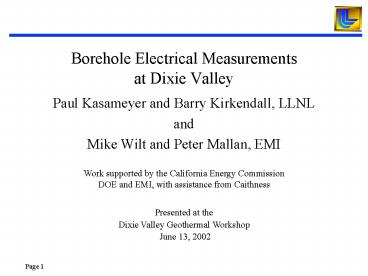Borehole Electrical Measurements at Dixie Valley - PowerPoint PPT Presentation
1 / 15
Title:
Borehole Electrical Measurements at Dixie Valley
Description:
GeoBilt is an experimental multi-frequency, multi-spacing EM log for geothermal ... Temperature data from Colin Williams; Fracture data from Colleen Barton ... – PowerPoint PPT presentation
Number of Views:37
Avg rating:3.0/5.0
Title: Borehole Electrical Measurements at Dixie Valley
1
Borehole Electrical Measurements at Dixie Valley
- Paul Kasameyer and Barry Kirkendall, LLNL
- and
- Mike Wilt and Peter Mallan, EMI
Work supported by the California Energy
Commission DOE and EMI, with assistance from
Caithness
Presented at the Dixie Valley Geothermal
Workshop June 13, 2002
2
GeoBilt is an experimental multi-frequency,
multi-spacing EM log for geothermal applications
3
GeoBILT was deployed at Dixie Valley in April,
2002
GeoBilt is an experimental multi-component,
multifrequency, high temperature Logging tool for
geothermal environments
4
66-21 is southeast of the producers
5
GeoBILT logged 1000 feet of well 66-21
6
Thermal problems prevented logging in 62A-23
7
Standard Induction logs in 66-21 are dull
1000 feet of log shows
- No correlation with changes in lithology
- No correlation with feed zone
- Only one signal that correlates with fractured
areas.
8
Multiple components provide new information
Coupled
Null Sensitive To radial asymmetry
Coplanar
9
GeoBilt Coupled signal similar to standard logs
- ZZRes is apparent resistivity from coupled
geometry - Not much character
- Does not identify feed zone
- No correlation with fracture aperture or
frequency except at one depth - Temperature data from Colin Williams Fracture
data from Colleen Barton
10
Null signals identify asymmetrical anomalies
- Signal will be zero if geology is flat or radial
dependent from the well. - Non-zero null signals are seen at isolated
depths. - Blue is magnetic north and green is east.
- Imaginary signal identifies three anomalous
zones. - Real signal identifies additional zones.
11
Anomalies could be dipping conductors
Imaginary
Null signal in X direction
Real
- We modeled a single conductive layer dipping 60
degrees in the X direction. - The null along strike is zero.
- Null signal points away from conductor.
12
The null signal at 7870 looks like the model
- Blue is magnetic north, green is east
- Imaginary is largest (Real probably has no
signal). - Sign reversal with broadest signal on top.
- Can determine strike and dip azimuth from
imaginary signal. - Strike is along near-zero magnetic north
- Conductor is west above intersection
13
Apparent strike and conductor azimuth 66-21
- Red determined from imaginary, blue from real.
- Circle size proportional to confidence
- Two strike azimuths are seen on log
- Conductor at 7880 ft. strikes 20 degrees and dips
towards 110 degrees - Two strike trends are seen in data
- What are we seeing?
14
Borehole televiewer shows fractures
- This image is just below the 7880 ft. anomaly
- Complementary sets of fractures
- Dip azimuths
- 285
- 90
- Data from Steve Hickman
15
In 66-21 a thin conductor at 7880 dips ESE
GeoBilt reveals similar strikes for other
features in the interval 7200 to 8200.































